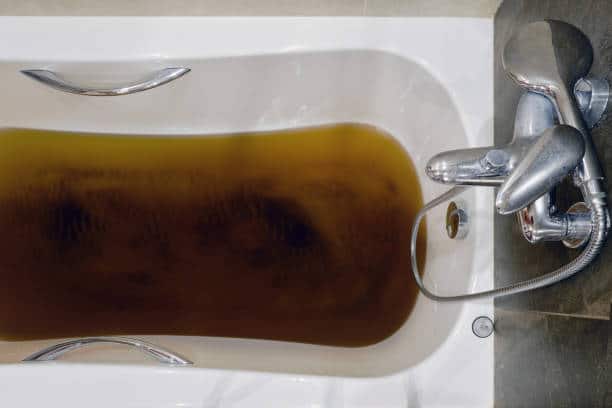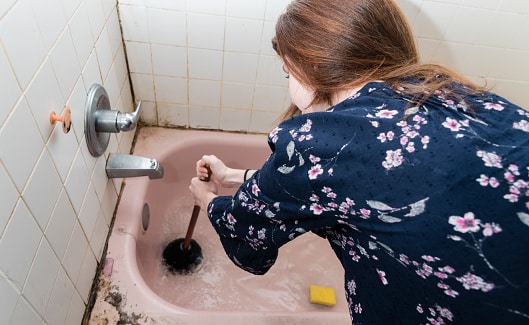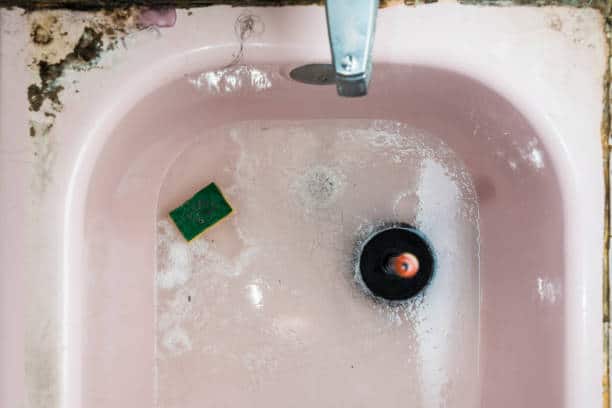When you’re dealing with a clogged bathtub drain, the annoyance can quickly grow into full-blown frustration. Don’t fret! With years of experience in resolving common plumbing problems, I’m here to guide you through the most frequent causes of bathtub clogs and how to fix them efficiently. Let’s dive right in!
Blocked Bathtub: Causes and Solutions
With any bathtub blockage, the key to an effective fix is understanding the root cause. From soap scum, hair, bath bombs, and cosmetic products to damaged pipes, the culprits can be diverse. Let’s break down the most common problems and how to tackle them.

1. Spotting the Problem
Recognize the issue before you take any action. For instance, if soap scum is the villain, a simple solution of boiling water and baking soda can dissolve it. If hair strands are causing trouble, a plunger could be your best ally. After identifying the cause, you can then proceed with the best course of action.
2. Cleaning Visible Blockages
Start by removing the standing water in your tub using a container, and wearing protective gloves for hygiene. Proceed to take off the drain stopper and manually clear any visible hair, soap scum, or other debris. Don’t forget to clean any grime off the drain cover too.
3. Using the Power of Boiling Water
Hot water is a miracle worker when it comes to melting grease, removing soap residue, and clearing other blockages. Once you’ve cleared the evident obstacles, boil around two liters of water and pour it down the drain. But if you have PVC (plastic) pipes, skip this step as hot water can cause damage.
4. The Magic Potion: Baking Soda and Vinegar
This home remedy not only clears drains but also helps in removing stains. Pour half a cup of baking soda followed by half a cup of white vinegar into the drain. Wait for around 15 minutes till the fizzing subsides, then flush the drain with two liters of boiling water.
5. Unclogging with a Plunger

If your bathtub still refuses to drain, it’s likely a deeper clog in the drain. In such a scenario, a cup-style plunger can create suction and push the obstruction through the pipe. Remember to seal the overflow hole to concentrate the pressure on the clog.
6. Employing a Plumbing Snake
If the plunger fails, a plumbing snake or auger can physically break up and remove the blockage. It’s a delicate process, as you wouldn’t want to damage your pipes. Hardware stores often have these tools for purchase or rental.
7. Resorting to Chemical Cleaners
If the clog is stubborn, a chemical cleaner could be the answer. These cleaners are available in liquid or gel form, and they break down the clog within a few minutes. Despite their effectiveness, these chemicals can be harsh on your pipes, so use them cautiously. After letting the cleaner sit for an hour, flush it with hot water. If your tub still doesn’t drain, it’s time to consider professional help.
Understanding the Typical Causes of Bathtub Blockages
It’s essential to understand the common causes behind a bathtub not draining, such as:
- Hair clogs: A frequent offender in shower and tub drain issues.
- Dirt and grease buildup: The grime washed off your body can sometimes accumulate in the drain line.
- Septic backup: If your tub isn’t draining properly or water is backing up, a septic system backlog could be the problem.
- Soap scum: Soap buildup can obstruct water flow, causing the drain to run slowly.
Preventing Future Bathtub Clogs
An ounce of prevention is worth a pound of cure, so here are some tips to avoid future clogs:
- Remove makeup before showering to prevent cosmetics from entering the sewer.
- Use bath products that dissolve easily.
- Never flush old cosmetics down the drain.
- Inspect your pipes every two years.
- Install a hair catcher to prevent hair and debris from causing blockages.
- Regularly inspect the drain and use a non-toxic cleaner.
- Occasionally, use a mixture of baking soda and vinegar to clear away particles stuck in the pipes.

When to Seek Professional Help
If you’ve exhausted your DIY efforts and the bathtub is still not draining, it might be time to seek professional assistance. Plumbers can diagnose and resolve complex issues, although their services can be more costly than self-troubleshooting. Do your research and ask relevant questions about rates, experience, and services before hiring.
Conclusion
Signs like gurgling sounds, slow drains, foul odors, and water backing up are all indicative of a clogged drain. Bathtub blockages can often be attributed to hair, cosmetics, bath bombs, soap scum, and damaged pipes. Solutions range from boiling water, vinegar, baking soda, a plunger, to a plumbing snake. To prevent future blockages, follow our prevention tips and maintain a regular cleaning routine. With these insights, you can keep your bathtub drain running smoothly, saving yourself from unnecessary repair costs and headaches.

Jay
Jay is a health and wellness enthusiast with expertise in water quality and nutrition. As a knowledgeable advocate for holistic well-being, Jay successfully manages Type 2 Diabetes through informed lifestyle choices. Committed to sharing reliable and authoritative insights, Jay combines firsthand experience with a passion for enhancing health."

